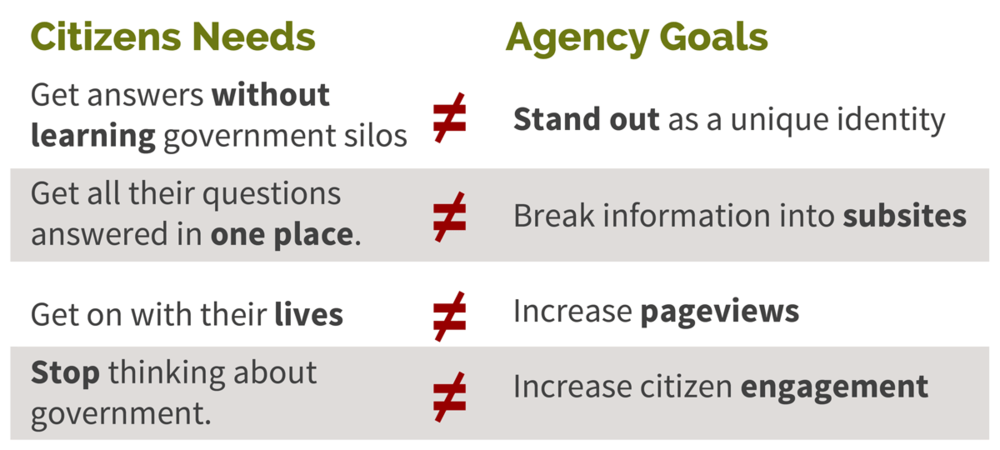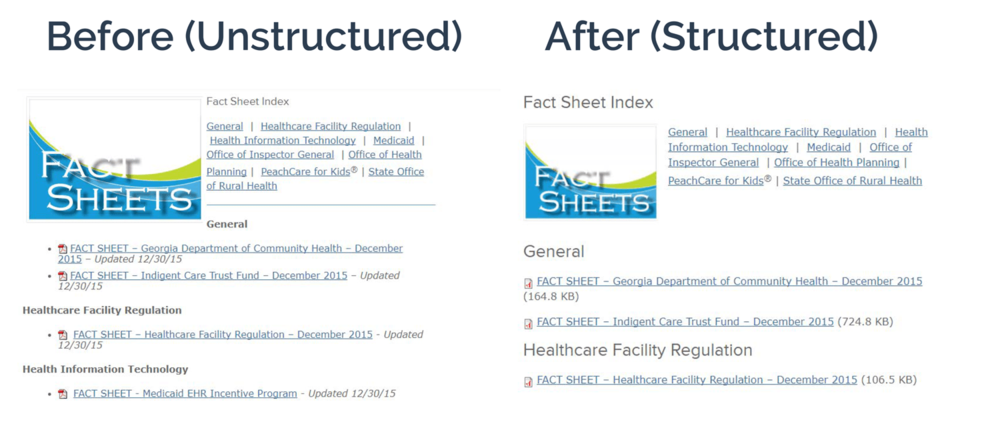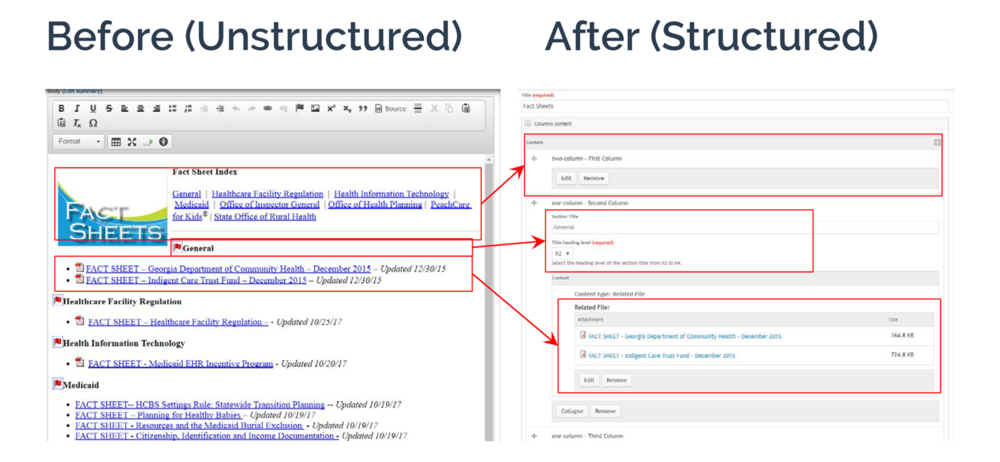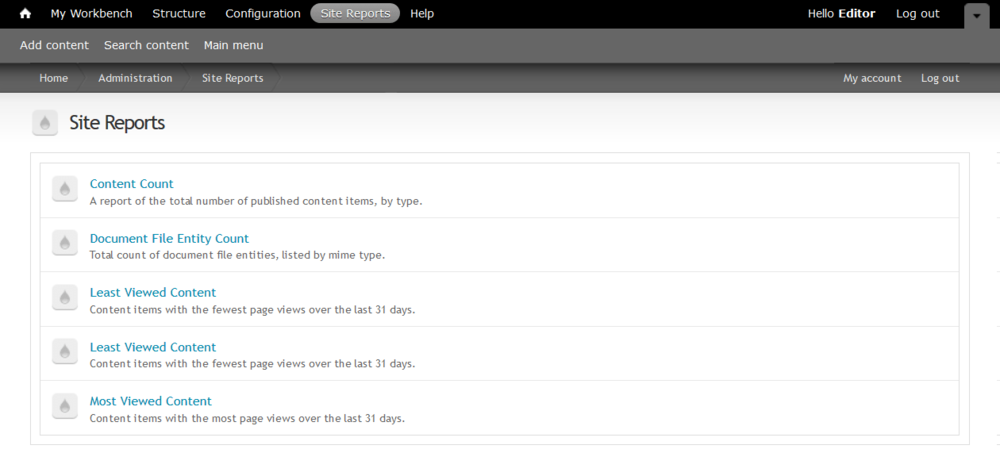
December 21, 2017
GOVTalks: The Future of Your Digital Information

This fall we came together for another GOVTalks, this time to talk with state agency employees about our plan for the future of our enterprise web platform. Our team has and will continue to focus a lot of energy on researching, planning, and building a technology solution to meet our ever growing and changing needs. But our end goal is less about a technology, and more about empowering our state partners to get their critical information to the people who need it — quickly, accurately. That will start with digital technology, but it ends with all the content owners across the state agencies and elected officials’ offices.
So before we talk about future facing technology, we need to look inward and think through the challenges and how they inform our goals. Next we’ll distill all of this information, and think long-term — we want to build something now that meets short-term needs, while being scalable to meet our long-term goals as a state. Finally, we looked at how agencies can start planning for that future now.
3 Challenges State Agencies Face
To start, we looked at 3 main challenges that I see agencies facing:
- Agencies face channel fatigue; they feel overwhelmed by the many ways their audiences seek their services.
- Agency information lives in disconnected silos.
- Agency goals often don’t align with their users’ needs.
Let’s unpack each of these just a bit.
Agency Challenge #1: Channel Fatigue
And so we pick up where Nikhil left off, with the overwhelm of channels we need to consider when we provide information and services. Some people may still rely on “traditional” means — office visits, phone calls, paper forms. Others are happy to get as many transactions completed online as they can. Even as we focus on maintaining a website, we know that some people have moved to other channels — mobile apps, social media, or even voice interfaces.
It’s tempting, as we hit this overwhelm, to pick a couple channels we feel comfortable with and focus there. It’s also tempting, as we think of ways to cut costs, to decide that we will drive all traffic to our online channels.
But the challenge is that while we need to think about all these options for channels, that doesn’t mean all our users have access to all the channels.
Our most recent numbers tell us that around 20% of Georgia households don’t have the internet.The DeKalb County school district tells us that closer to 50% of their students don’t have internet in their homes. While you may think this is because those families all rely on their smartphones to connect, that’s often not the case in these underprivileged populations. Many still aren’t connected at all.
So while in Georgia, we can brag that 90% of our residents have access to broadband services in their area, that doesn’t mean they can afford broadband in their homes. It also doesn’t mean they’re all interested in having internet access, using a computer, or even “being connected.”
Put simply, internet availability in a geographic area does not always translate to internet access in the home. That tells us a pretty large percentage of Georgian’s will come to us through “traditional” channels, in perpetuity.
So though we can drive some people to digital channels, we are still going to need phone lines, and we’re still going to need paper. We can’t phase them out, and we need to consider how to reach underserved groups who don’t have the luxury of a mobile data plan or in-home internet.
So our first challenge to providing government information and services is the sheer number of channels we need to serve. We can’t just focus on providing services for the one channel we are most comfortable with. We need to think about how to provide for all of them, and understand that different user groups will be comfortable with some and not others.
Agency Challenge #2: Information Lives in Silos
As we zoom out on those channels, we know that we store the answers and information for each one separately, per agency, and often, per division. They have different systems, different sources for those answers — what we might refer to as sources of truth. So it’s easy for content in different channels to fall out of date, and for an agency to have correct policies or expectations in one place, but not update another. This means huge chances that people will come across incorrect, outdated information on any one channel.
And our mess of information means it’s really hard for people to get the information they need. They may get a different answer from a call center than online — and that’s where trust begins to erode.
It’s a complex challenge with no easy answer … but one that our team keeps at top of mind as we think about how to architect a future digital information platform.
So here we are on one side, we have an audience in need of information or services. On the other side, we have agencies trying to provide those information and services. This brings us to challenge #3. Because, we found through user research discoveries that user needs are often directly at odds with agency goals.
Agency Challenge #3: User Needs do not match Agency Goals
Let’s take a detailed look at some findings that stood out to us from our recent user research. We aimed to better understand the needs of people seeking services or information from state agencies, and compare those to the goals of the agencies.
We found that the public looks for signs that a state site is “official.” So they were more likely to trust a site that displayed the state seal than they were to trust an agency’s self-branding (their own logo, colors, etc). The appreciated the common, consistent design across different state web properties, and this was even more apparent when an agency site linked off to an older agency web application with different styling; the users were thrown aback, and distrusted the site that looked markedly different from the rest.
Following on that same thread, the public doesn’t trust websites with a lot of outdated graphics or banners, but at the same time they don’t like when a site has no graphics at all. While they distrusted an older-looking website, they also distrusted sites that they felt were over polished or flashy … and particularly distrusted anything that felt like the government was marketing to them. They didn’t want to feel like the state was “selling” their services.
The study also found — and this should be no surprise — that people who aren’t in public service don’t understand the divisions in our government. Not only do they not understand the differences between different state agencies and their divisions, but they often don’t understand the difference between local, state, and federal government. To most people, we’re all “the government,” and we’re all working in one big room together on everything.
To the public, we are all GeorgiaGov; the divisions between them are just confusion.
So people looking for particular services start with Google, and they type in a search term that they think will help them. Most users then expect the first site they find will have all the information they need. So if that site doesn’t provide all their answers, the user will just give up and either pick up the phone, go into an office to talk to someone, or stop seeking that service. In a nutshell, all of this confirms that we need to build in more continuity between State of Georgia sites.
But here’s the rub. When we compare that list of user needs above to the conversations we have with agencies, we find that often they’re at odds. And that poses a real challenge for all of us. Agencies tell us they want to stand out as their own identity, they want to break their sites up into smaller sub-sites, and they want to drive more users to be “actively engaged” with their agency by reading their press releases, attending their events, and so on. The problem is, none of those goals align with what their users need.

I feel like I’m being harsh here, but I also think it’s important for us to be realistic about the role we play. The typical person wants to spend as little time as possible interacting with their government so they can live their busy lives. How can we help them do that? Instead of talking about increasing engagement, how can we see our value in easing friction and helping Georgians as unintrusively as we can?
Ask yourself: Are your agency goals aligned with your audience’s needs? Where should they be more aligned? Where is it reasonable and beneficial to try to nudge targeted groups of users to be more aligned with your goals?
Digital Platform Goals
Now that we understand the challenges, let’s take a look at some of our team’s high-level goals to address them. How can we find the balance between addressing the public’s needs and agencies’ needs, even when the two seem to conflict? Well, to start, we look for commonalities.
Platform Goal #1: Ease Digital Frustration and the Silo Effect for Agencies, While Reducing Friction for Users
We know that a unifying government brand across agencies can help ease confusion for end users and signify that they’re in the right place. But we need to do that while giving each agency enough flexibility in the designs and the page layouts that they still see their own goals reflected in them.
We also know we want to increase searchability between sites, and improve the connections between channels to help people more readily find that they’re looking for. Improving our system’s methods of organizing content and files can go a long way in both helping our agency content managers, and bridging those connections for end users.
Platform Goal #2: Collaborate More with our Agency Partners
As we think more about unifying our branding and content for end users, we know that to do any of this well, we need to work more closely with all of the agencies involved. We want to better understand the goals of our agency partners so we can help you achieve them, and we want to make sure we’re all headed in the same direction.
To get us there, in the short run we will put together some working groups to help us refine new enterprise digital standards and policies. We are also talking about organizing some content strategy user groups, so agency content managers can share wins and frustrations, and help each other along the way. We’ll communicate more about those in the coming months, as we get them going.
Platform Goal #3: Build Towards a Single Source of Truth
Ultimately, the grand vision is to build toward a single source of truth for key content from all agencies. So you can manage information in one place, and people get the right answer each time, and their experience is seamless. Call centers, websites, applications, social media, chat, text … wherever the users are, that’s where we want your information to be available.
But there is a tradeoff to achieving that goal of a system that manages clean, reliable content. We can’t do that while also building a system that treats each web page like its own separate Word document. For content to disperse across channels, it needs to be well written, and well structured. This brings us to the most pressing question from our agency content managers: “What do I need to do right now — with my current site — to plan for this future state?”
What does that mean for me RIGHT NOW?
In the GOVTalks video at the end of this post, I detail some of the more practical and immediate actions our content managers can take to clean up their sites and ease the transition to a new platform in the future.
Because we’re still in the discovery phases of planning a new environment, we’re not far enough along to detail a migration plan. But we do know that we won’t migrate all the content as-is from the old site. We will migrate good content. Good content is structured and well written.
Don’t think pages. Think chunks of information.
Last year I talked in detail about the value of structured content. If you missed it, now is a great time to revisit that concept.
Agency Action Item #1: If you care about it, chunk it.
So as you’re planning to future-proof your content, if you care about it, chunk it. That means using the right content type for the content; Locations in the Locations content type, for example.
But that also means chunking your important Site Pages and files. Make sure your key information is well written, and well organized. Columns is a newer feature built to help you chunk your content more easily on Site Pages and Blog Entries. Links to Files should be grouped in Related File fields, images in the Image or Infographic fields, videos embedded using the Video field.
Agency Action Item #2: Structure the files you want to keep.
This is the piece I stress over the most — file migration is going to be a huge lift.
Files (like PDFs) that are linked from the WYSIWYG body field instead of being uploaded as Related Files will be very hard to track and migrate. But you can start getting a handle on your files now by moving lists of PDF links out of the unstructured Body field and into structured Columns fields.


Agency Action Item #3: If you don’t need it, delete it.
There’s never been a better time to run a content audit of your site. If you regularly archive content you don’t need, not only do you make your site more usable for visitors, but you’re reducing that stress of reviewing it later to figure out if you need to migrate it or not.
Agency content managers on our platform can access reports of the 100 least viewed and 100 most viewed content items in the last 31 days. Simply log into your site, then look under Site Reports for links to both lists.

Agency Action Item #4: Level up!
We are going to continue preaching to agency leadership that to stay relevant, it’s important to have mature content strategists empowered to manage agency information. Who better to be those content strategist for your agency than you?
So if you haven’t already, sign up for our upcoming State Certified Content Specialist Course. This course series is designed to help you understand your audiences, your goals, and how to wrangle your content now. This series is free for state content managers, and we’ve put it together specifically to help you all prepare for GeorgiaGov’s digital future.
GOVTalks: The Future of Your Website
See all talks from the event, blog post recaps, and slide decks in our archive page.
